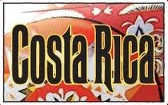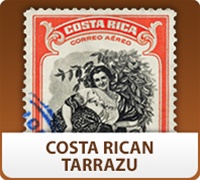Café de Costa Rica
 Coffee production in the country began in 1779 in the Meseta Central which had ideal soil and climate conditions for coffee plantations. Coffea Arabica first imported to Europe through Arabia, whence it takes its name, was introduced to the country directly from Ethiopia. In the nineteenth century, the Costa Rican government strongly encouraged coffee production, and the industry fundamentally transformed a colonial regime and village economy built on direct extraction by a city-based elite towards organized production for export on a larger scale. The government offered farmers plots of land for anybody who wanted to harvest the plants. The coffee plantation system in the country therefore developed in the nineteenth century largely as result of the government’s open policy. Soon coffee became a major source of revenue surpassing cacao, tobacco, and sugar production as early as 1829.
Coffee production in the country began in 1779 in the Meseta Central which had ideal soil and climate conditions for coffee plantations. Coffea Arabica first imported to Europe through Arabia, whence it takes its name, was introduced to the country directly from Ethiopia. In the nineteenth century, the Costa Rican government strongly encouraged coffee production, and the industry fundamentally transformed a colonial regime and village economy built on direct extraction by a city-based elite towards organized production for export on a larger scale. The government offered farmers plots of land for anybody who wanted to harvest the plants. The coffee plantation system in the country therefore developed in the nineteenth century largely as result of the government’s open policy. Soon coffee became a major source of revenue surpassing cacao, tobacco, and sugar production as early as 1829.
 Exports across the border to Panama were not interrupted when Costa Rica joined other Central American provinces in 1821 in a joint declaration of independence from Spain. In 1832, Costa Rica, at the time a state in the Federal Republic of Central America, began exporting coffee to Chile where it was re-bagged and shipped to England under the brand of “Café Chileno de Valparaíso”. In 1843, a shipment was sent directly to the United Kingdom by William Le Lacheur Lyon, captain of the English ship, The Monarch, who had seen the potential of directly cooperating with the Costa Ricans. He sent several hundred-pound bags and following this the British developed an interest in the country. They invested heavily in the Costa Rican coffee industry, becoming the principal customer for exports until World War II. Growers and traders of the coffee industry transformed the Costa Rican economy, and contributed to modernization in the country, which provided funding for young aspiring academics to study in Europe. The revenue generated by the coffee industry in Costa Rica funded the first railroads linking the country to the Atlantic Coast in 1890, the “Ferrocarril al Atlántico”. The National Theater itself in San José is a product of the first coffee farmers in the country.
Exports across the border to Panama were not interrupted when Costa Rica joined other Central American provinces in 1821 in a joint declaration of independence from Spain. In 1832, Costa Rica, at the time a state in the Federal Republic of Central America, began exporting coffee to Chile where it was re-bagged and shipped to England under the brand of “Café Chileno de Valparaíso”. In 1843, a shipment was sent directly to the United Kingdom by William Le Lacheur Lyon, captain of the English ship, The Monarch, who had seen the potential of directly cooperating with the Costa Ricans. He sent several hundred-pound bags and following this the British developed an interest in the country. They invested heavily in the Costa Rican coffee industry, becoming the principal customer for exports until World War II. Growers and traders of the coffee industry transformed the Costa Rican economy, and contributed to modernization in the country, which provided funding for young aspiring academics to study in Europe. The revenue generated by the coffee industry in Costa Rica funded the first railroads linking the country to the Atlantic Coast in 1890, the “Ferrocarril al Atlántico”. The National Theater itself in San José is a product of the first coffee farmers in the country.
Coffee was vital to the Costa Rican economy by the early to mid-20th Century. Leading coffee growers were prominent members of society. Due to the centrality of coffee in the economy, price fluctuations from changes to conditions in larger coffee producers, like Brazil, had major reverberations in Costa Rica. When the price of coffee on the global market dropped, it could greatly impact the Costa Rican economy.
At present, the production of coffee in the Great Metropolitan Area around the capital of San José has decreased in recent years due to the effects of urban sprawl. As the cities have expanded into the countryside, poor plantation owners have often been forced to sell up to building corporations.
Source: Wikipedia – The Free Encyclopedia







